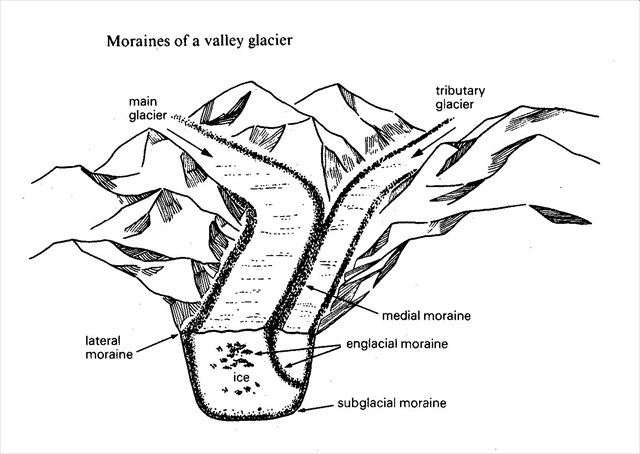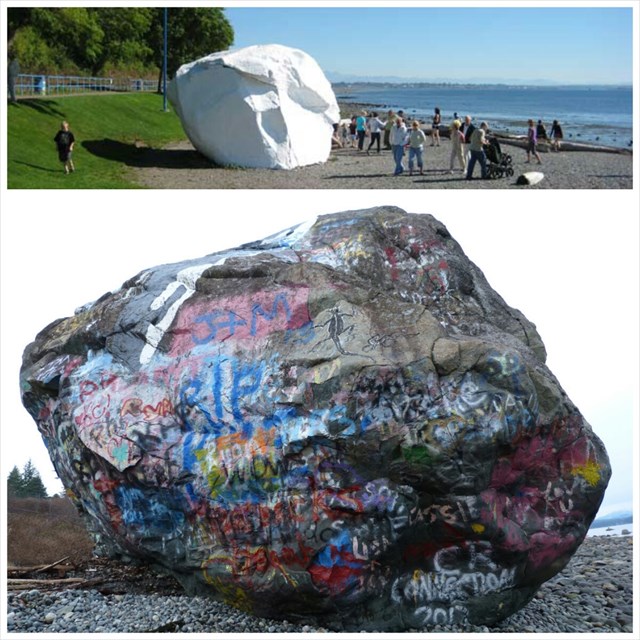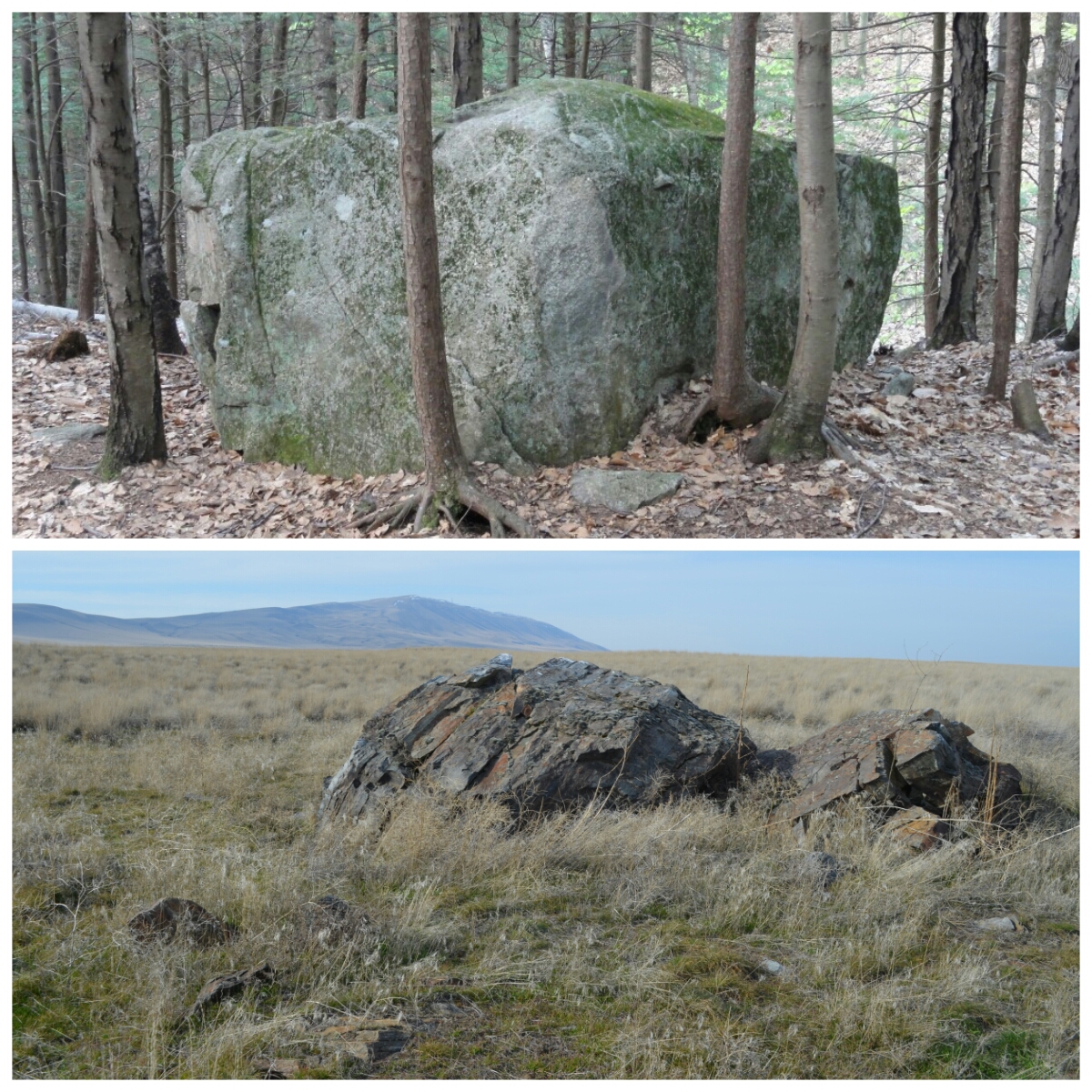Welcome to Cadboro Gyro Park Beach. This park/beach is a favorite destination for people from all over because of it's fantastic beach and children's play park, and also home to a surprise earth science lesson I didn't notice the many times I have walked here. Please park at the provided parking waypoint and access the Beach via the obvious access point nearby. High tide can be your enemy here so be sure to plan your trip accordingly. Please be respectful to the various other people that may be using the beach, and most of all enjoy the earthcache.
What are Glacial Erratics?
 "Glacial Erratcis" are pieces of rock that were once trapped in the ice of glaciers. Here on Vancouver Island glaciers three quarters of a mile deep carved their way through forming the landscape we know using the abrasive power of something called "Glacial Moraine" about 15,000 years ago. The "Moraine" would become trapped in the ice by various means like being picked up, or by falling onto the surface of the glacier as rock cracked from mountains and valleys. While a lot of it would be as I mentioned trapped in the ice, some of it would be traveling on top or be buried into sheets of snow that would eventually freeze. But regardless they would be along for the ride.
"Glacial Erratcis" are pieces of rock that were once trapped in the ice of glaciers. Here on Vancouver Island glaciers three quarters of a mile deep carved their way through forming the landscape we know using the abrasive power of something called "Glacial Moraine" about 15,000 years ago. The "Moraine" would become trapped in the ice by various means like being picked up, or by falling onto the surface of the glacier as rock cracked from mountains and valleys. While a lot of it would be as I mentioned trapped in the ice, some of it would be traveling on top or be buried into sheets of snow that would eventually freeze. But regardless they would be along for the ride.
Time went on and our world began to warm up, and the ice began to melt. The glaciers as they began to disappear started to leave behind these pieces of rock, creating what we call "Glacial Erratics". They were of all shapes and sizes, some being small stones while others boulders that could be upwards to hundreds of feet long and high! They were alien to these places due to being of a completely different type of rock, and they had traveled hundreds of kilometers from where they once belonged. And they stood in stark comparison to the dark bedrock that would be native to the places these lonely travelers now called home.
Erratics and Their Cultural Significance
 Today the Erratics we find strewn about in various locations have become a part of our landscape. The world has changed since the glaciers dropped these rocks off, but they have had their impact on the various societies that have appeared over the millennia. For example, some of the larger erratics along the local coastline have had influences on the first nations people. Two very prominent examples are Harpoon rock at Harling Point and Devil Fish Rock in Gonzales Bay. The Songhees people have legends about those particular erratics that have to do with their "creator" Haylas the Transformer. I would suggest if you want to learn about their legends to take the time to do a search on the internet and see what they are all about.
Today the Erratics we find strewn about in various locations have become a part of our landscape. The world has changed since the glaciers dropped these rocks off, but they have had their impact on the various societies that have appeared over the millennia. For example, some of the larger erratics along the local coastline have had influences on the first nations people. Two very prominent examples are Harpoon rock at Harling Point and Devil Fish Rock in Gonzales Bay. The Songhees people have legends about those particular erratics that have to do with their "creator" Haylas the Transformer. I would suggest if you want to learn about their legends to take the time to do a search on the internet and see what they are all about.
 Fast forward to today, various cities have formed around some of the gigantic erratics that were left behind. A good example of this is White Rock, BC. Here is a giant white rock once again left behind by glaciers. I am very sure there is legends tied with this rock too by the first nations of that area, so I do suggest looking that up. As well there is the "Big Rock" of Campbell River two kilometres south of the downtown core of Campbell River. This forty foot tall monolith is the proprietor of numerous local First Nations cultural legends in relation to its origin. The scientific explanation is that Big Rock is an erratic, which was embedded in an glacier during the last ice age and was carried to its present location where it was deposited.
Fast forward to today, various cities have formed around some of the gigantic erratics that were left behind. A good example of this is White Rock, BC. Here is a giant white rock once again left behind by glaciers. I am very sure there is legends tied with this rock too by the first nations of that area, so I do suggest looking that up. As well there is the "Big Rock" of Campbell River two kilometres south of the downtown core of Campbell River. This forty foot tall monolith is the proprietor of numerous local First Nations cultural legends in relation to its origin. The scientific explanation is that Big Rock is an erratic, which was embedded in an glacier during the last ice age and was carried to its present location where it was deposited.
Erratics and How to Identify Them
 There are a few ways one could easily identify an erratic. The simplest way is when the bedrock is exposed. When this happens you will notice the difference right away, espcially here in Victoria. The majority of erratics I have seen here have been boulders of Granodiorite.
There are a few ways one could easily identify an erratic. The simplest way is when the bedrock is exposed. When this happens you will notice the difference right away, espcially here in Victoria. The majority of erratics I have seen here have been boulders of Granodiorite.
Granodiorite is a stone that has a salt and pepper look to it, where the white parts are tiny crystalline structures that sparkle in light. These stand out in stark contrast to the dark bedrock found near our local shoreline. It's at these places where you may also notice striations. These are scratches or grooves in the bedrock that are created by glacial moraine which is what most of these erratics used to be at one time or another.
But what if there is nothing like that at all near by? What if it's in the middle of a field, or forest? What if its on a rocky, or sandy beach?
Well the answer to that would be simple. You see, just take a look around you. That forest you stand in could be devoid of any hill or mountain where your specimen could have come from. Same with that field too. And that rocky and sandy beach could be no where near where that giant rock could possibly come from as well. It is going to stand out, look different and very alien to the location you have found it.
Questions and Logging Requirements for this Earthcache
To log this earthcache please answer the following questions by emailing me via my profile here on geocaching.com
1) What kind of rock is this erratic, and how can you tell (hint: it's mentioned in the body of this lesson)?
2) Since there is no exposed bedrock or striations present at this location, what are two ways that you can tell that this is an erratic?
3) Someone has carved an image into the side of this erratic. What is it that they have carved? (2 things)
4) OPTIONAL Take a picture of you and or your group on the beach and post it with your log. Please do not post any pictures of the erratic itself at it's location. This will help dissuade any armchair logging of this earthcache.